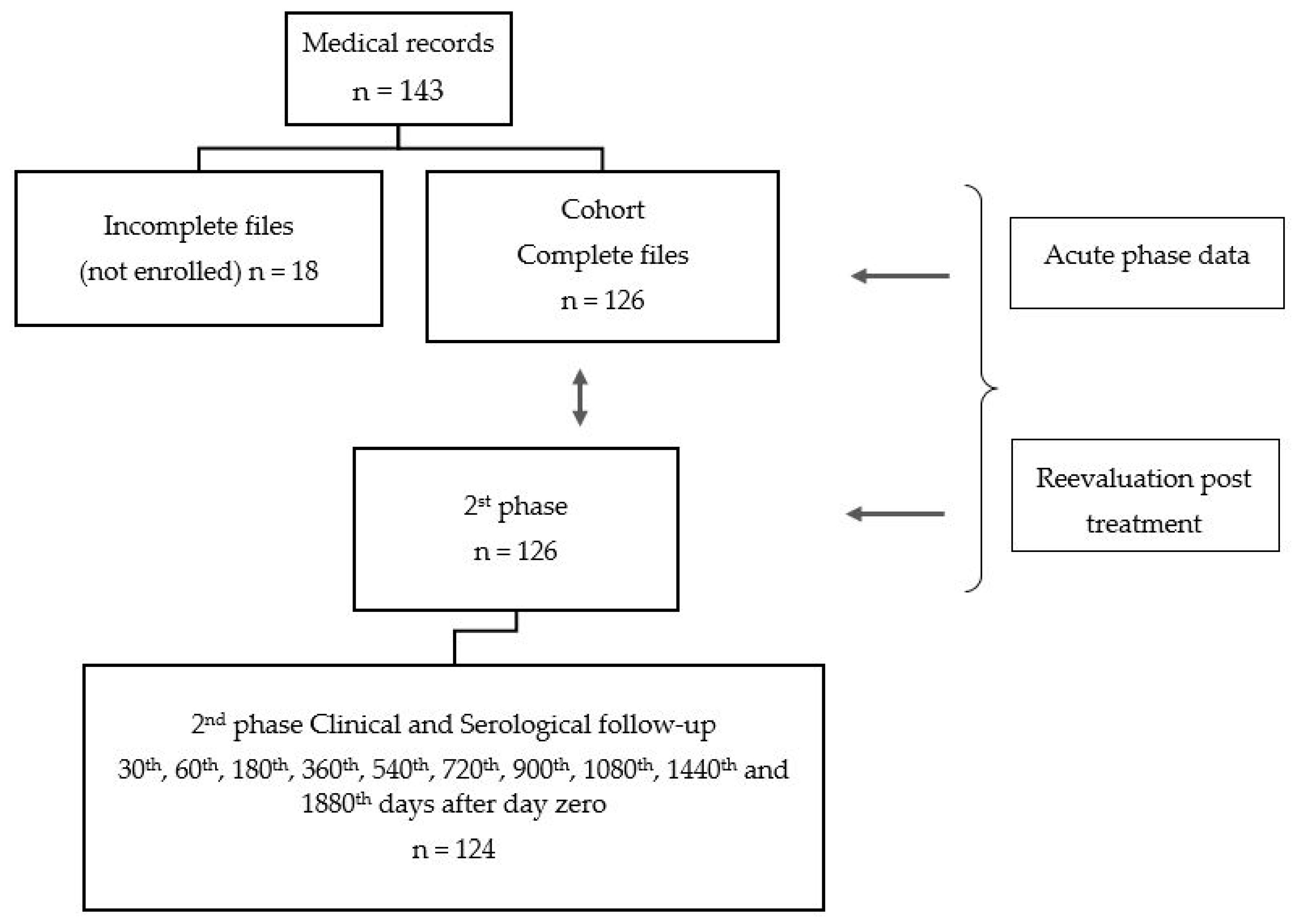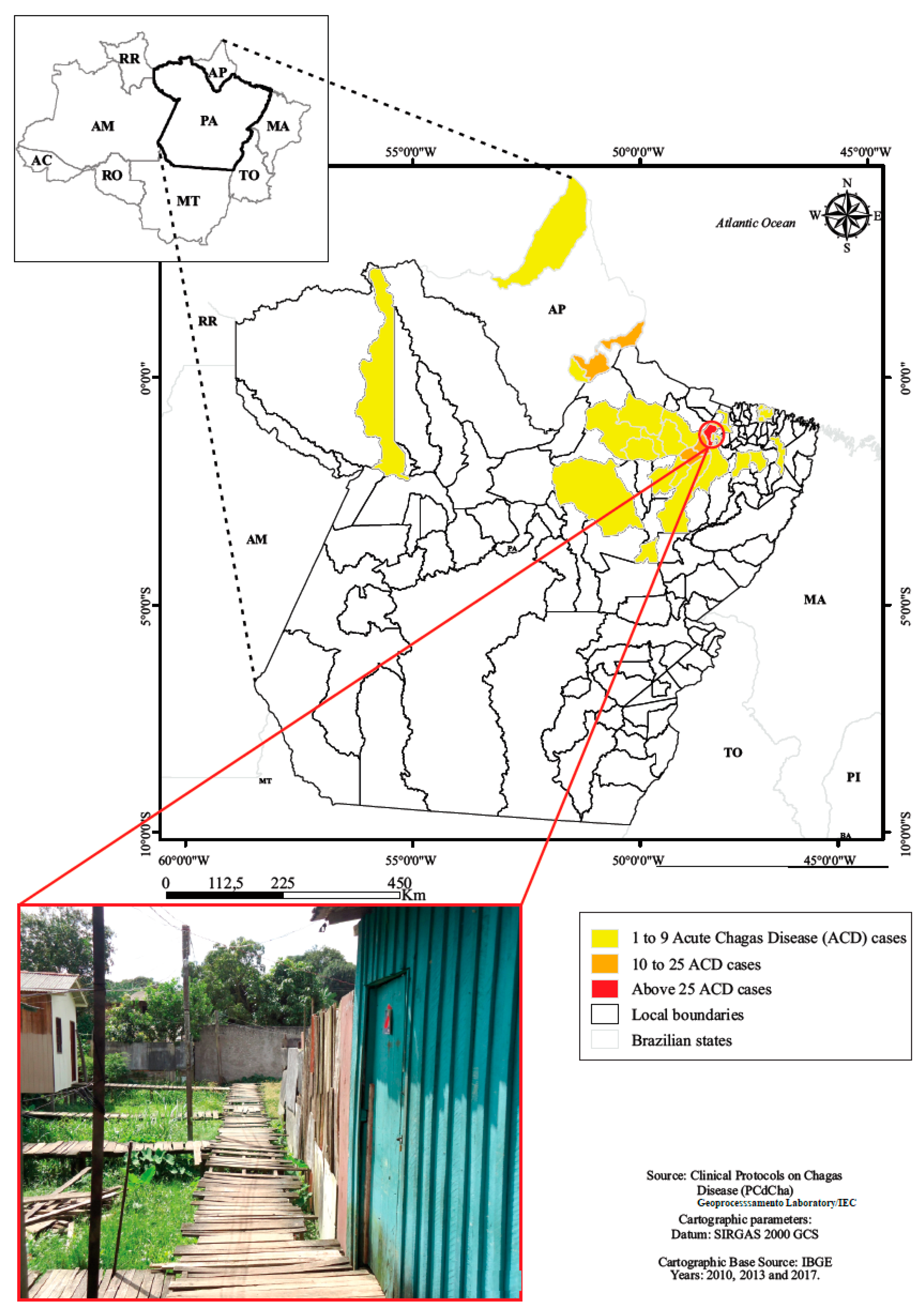Clinical, Cardiological and Serologic Follow-Up of Chagas Disease in Children and Adolescents from the Amazon Region, Brazil: Longitudinal Study
Abstract
:1. Introduction
2. Materials and Methods
- (1)
- Severe cardiac involvement: heart failure caused by chagasic infection as evidenced by echocardiogram results demonstrating severe myopericarditis with pericardial effusion;
- (2)
- Moderate cardiac involvement: myocarditis accompanied by sinus tachycardia or other arrhythmias with pericarditis and pericardial effusion;
- (3)
- Mild cardiac involvement: myocarditis accompanied by sinus tachycardia or other simple conduction disorders.
3. Results
3.1. Demographic Data, Origin and Spatial Distribution
3.2. Clinical Features
3.3. Acute Phase Cardiac Involvement
3.4. Response to Treatment, Adverse Effects and Serologic Follow-Up after Treatment
4. Clinical Follow-Up According to Serologic and Cardiac Evaluation
5. Discussion
Author Contributions
Funding
Acknowledgments
Conflicts of Interest
References
- Panamerican Health Organization (PAHO/WHO). Guide to Surveillance, Prevention, Control and Clinical Management of Acute Chagas Disease Transmitted by Food; Technical Manuals Series, 12; PAHO: Rio de Janeiro, Brazil, 2009; p. 92. (In Brazilian) [Google Scholar]
- Valente, S.A.D.S.; da Costa Valente, V.; das Neves Pinto, A.Y.; de Jesus Barbosa César, M.; dos Santos, M.P.; Miranda, C.O.S.; Cuervo, P.; Fernandes, O. Analysis of an acute Chagas disease outbreak in the Brazilian Amazon: Human cases, triatomines, reservoir mammals and parasites. Trans. R. Soc. Trop. Med. Hyg. 2009, 103, 291–297. [Google Scholar] [CrossRef]
- Pinto, A.Y.D.N.; Valente, V.D.C.; Coura, J.R.; Valente, S.A.D.S.; Junqueira, A.C.V.; Santos, L.C.; De Macedo, R.C. Clinical Follow-Up of Responses to Treatment with Benznidazol in Amazon: A Cohort Study of Acute Chagas Disease. PLoS ONE 2013, 8, e64450. [Google Scholar] [CrossRef] [Green Version]
- Pinto, A.Y.N. American Trypanosomiasis. In Red Book:2018 Report of the Committee in Infectious Disease, 31th ed.; Kimberlin, D.W., Brady, M.T., Jackson, M.A., Long, S.S., Eds.; American Academy of Pediatrics: Itasca, IL, USA, 2018; Volume I, pp. 826–829. [Google Scholar]
- Pinto, A.Y.N.; Valente, S.A.S.; Valente, V.C.; Ferreira, A.R., Jr.; Coura, J.R. Acute phase of Chagas disease in the Amazon: Brazilian study of 233 cases from Pará, Amapá and Maranhão observed between 1988 and 2005. Rev. Soc. Bras. Med. Trop. 2008, 41, 602–614. [Google Scholar] [CrossRef] [PubMed] [Green Version]
- Pinto, A.Y.N.; Valente, S.A.S.; Valente, V.C. Emerging acute Chagas disease in Amazonian Brazil: Case reports with serious cardiac involvement. Braz. J. Infect. Dis. 2004, 8, 458–464. [Google Scholar] [CrossRef] [PubMed]
- de Barros Moreira Beltrão, H.; de Paula Cerroni, M.; de Freitas, D.R.C.; das Neves Pinto, A.Y.; da Costa Valente, V.; Valente, S.A.; Costa, E.D.G.; Sobel, J. Investigation of two outbreaks of suspected oral transmission of acute Chagas disease in the Amazon region, Pará State, Brazil, in 2007. Trop. Doct. 2009, 39, 231–232. [Google Scholar] [CrossRef] [PubMed]
- Secretaria de Vigilância em Saúde. Ministério da Saúde Brasil. Boletim Epidemiológico Doença de Chagas Aguda e Distribuição Espacial dos triatomíneos de Importância Epidemiológica, Brasil 2012 a 2016; MS: Brasília, Brazil, 2019; Volume 50, p. 10.
- Ostermayer, A.L.; Passos, A.D.C.; Silveira, A.C.; Ferreira, A.W.; Macedo, W.; Prata, A.R. National seroprevalence survey evaluation of the control of Chagas disease in Brazil (2001–2008). Rev. Soc. Bras. Med. Trop. 2011, 44, 108–121. [Google Scholar] [CrossRef] [PubMed] [Green Version]
- Dias, J.C.P.; Ramos, N.A., Jr.; Gontijo, E.D.; Luquetti, A.; Shikanani-Yasuda, M.A.; Coura, J.R. II Consenso brasileiro em doença de Chagas, 2015. Epidemiologia e Serviços de Saúde 2016, 25, 7–86. [Google Scholar] [CrossRef] [PubMed]
- Rassi, A.; Ferreira, H.O. Attempts of specific treatment of the acute stage of Chagas’ disease with nitrofurans in prolonged schemes. Rev. Soc. Bras. Med. Trop. 1971, 5, 235–262. [Google Scholar] [CrossRef] [Green Version]
- Pinto, A.Y.N.; Farias, J.R.; Marçal, A.S.; Galucio, S.; Costi, R.R.; Valente, V.C. Severe acute Chagas disease in the Amazon indigenous Brazilian. Available online: http://scielo.iec.gov.br/pdf/rpm/v21n2/v21n2a02.pdf (accessed on 12 August 2020).
- Shikanai-Yasuda, M.A.; Lopes, M.H.; Tolezano, J.E.; Umezawa, E.; Amato, V.N.; Barreto, A.C.; Higaki, Y.; Moreira, A.A.; Funayama, G.; Barone, A.A. Acute Chagas’ disease: Transmission routes, clinical aspects and response to specific therapy in diagnosed cases in an urban center. Rev. Inst. Med. Trop. 1990, 32, 16–27. [Google Scholar] [CrossRef] [PubMed] [Green Version]
- Alarcón de Noya, B.; Díaz-Bello, Z.; Colmenares, C.; Ruiz-Guevara, R.; Mauriello, L.; Zavala-Jaspe, R.; Suarez, J.A.; Abate, T.; Naranjo, L.; Paiva, M.; et al. Large Urban Outbreak of Orally Acquired Acute Chagas Disease at a School in Caracas, Venezuela. J. Infect. Dis. 2010, 201, 1308–1315. [Google Scholar] [CrossRef] [PubMed] [Green Version]
- Pinto, A.Y.N.; Ferreira, S.M.A.G.; Valente, S.A.S.; Valente, V.C.; Ferreira, A.G., Jr. Electrocardiographic changes during and after treatment with benznidazole in acute stage of Chagas disease indigenous to the brazilian Amazon. Revista Pan-Amazônica de Saúde 2010, 1, 67–76. [Google Scholar]
- Altcheh, J.; Moscatelli, G.; Moroni, S.; Garcia-Bournissen Freilij, H. Adverse events after the use of benznidazole in infants and children with Chagas disease. Pediatrics 2011, 127, e212–e218. [Google Scholar] [CrossRef] [PubMed] [Green Version]
- Meymandi, S.; Hernandez, S.; Park, S.; Sanchez, D.R.; Forsyth, C. Treatment of Chagas Disease in the United States. Curr. Treat. Options Infect. Dis. 2018, 10, 373–388. [Google Scholar] [CrossRef] [PubMed] [Green Version]
- Machado-de-Assis, G.F.; Diniz, G.A.; Montoya, R.A.; Dias, J.C.P.; Coura, J.R.; Machado-Coelho, G.L.L.; Albajar-Viñas, P.; Torres, R.M.; Lana, M.D. A serological, parasitological and clinical evaluation of untreated Chagas disease patients and those treated with benznidazole before and thirteen years after intervention. Memórias do Instituto Oswaldo Cruz 2013, 108, 873–880. [Google Scholar] [CrossRef] [PubMed]
- Morillo, C.; Marin-Neto, J.A.; Avezum, A.; Sosa-Estani, S.; Rosas, F.; Villena, E.; Quiroz, R.; Bonilla, R.; Britto, C.; Guhl, F.; et al. Benefit Investigators. Randomized trial of benznidazole for chronic Chagas’ cardiomyopathy. N. Engl. J. Med. 2015, 373, 1295–1306. [Google Scholar] [CrossRef] [PubMed] [Green Version]
- Carlier, Y.; Torrico, F.; Russomando, G.; Luquetti, A.; Freilji, H.; Albajar Vinas, P. Congenital Chagas disease: Recommendations for diagnosis, treatment and control of newborns, siblings and pregnant women. PLoS Negl. Trop. Dis. 2011, 5, e250. [Google Scholar] [CrossRef] [PubMed]





| Epidemiological Data | Frequency | % |
|---|---|---|
| Age (years) | ||
| 0–2 | 4 | 3.2 |
| 3–7 | 20 | 15.9 |
| 8–11 | 40 | 31.8 |
| 12–17 | 62 | 49.2 |
| Gender | ||
| Female | 46 | 36.6 |
| Male | 80 | 63.4 |
| Origin | ||
| Pará State regions | ||
| Baixo Amazonas | 1 | 0.8 |
| Marajó Island | 26 | 20.8 |
| Metropolitan area of Belém | 52 | 41.2 |
| Northeast | 41 | 32.5 |
| Southeast | 2 | 1.6 |
| Amapá State | ||
| Santana | 4 | 3.2 |
| Transmission form | ||
| Oral | 86 | 68.3 |
| Vectorial | 19 | 15.1 |
| Vertical | 2 | 1.6 |
| Undefined | 19 | 15.1 |
| Outbreak | ||
| Yes | 90 | 71.4 |
| No | 35 | 27.8 |
| Undefined | 1 | 0.8 |
| Clinical Manifestations | Frequency | % | Clinical Manifestations | Frequency | % |
|---|---|---|---|---|---|
| Fever | 117 | 92.8 | Hepatomegaly | 34 | 26.9 |
| Headache | 74 | 58.7 | Chills | 27 | 21.4 |
| Pallor | 64 | 50.8 | Caught | 24 | 19.0 |
| Myalgia | 56 | 44.4 | Splenomegaly | 24 | 19.0 |
| Abdominal pain | 54 | 42.8 | Exanthema | 20 | 15.9 |
| Edema of face | 53 | 42.1 | Edema of lower limbs | 19 | 15.1 |
| Adenopathy | 49 | 38.9 | Chest pain | 13 | 10.3 |
| Dyspnea | 45 | 35.7 | Palpitations | 13 | 10.3 |
| Arthralgia | 44 | 34.9 | Nodules in lower limbs | 4 | 3.2 |
| Diarrhea | 34 | 26.9 | Inoculation lesion | 4 | 3.2 |
| Hematological Analysis | 6–23 Months | 2–6 y | 7–9 y | ≥10 y (Female) | ≥10 y (Male) | Total N% | |
|---|---|---|---|---|---|---|---|
| Anemia | 6 | 11 | 11 | 14 | 20 | 62 | 49.2 |
| Reference hemoglobin concentration rate | 2 | 6 | 6 | 3 | 9 | 25 | 19.8 |
| Reference leukocytes count | 3 | 10 | 15 | 11 | 27 | 66 | 52.3 |
| Leukocytosis | 5 | 6 | 2 | 1 | 14 | 11.1 | |
| Leukopenia | 1 | 2 | 3 | 1 | 7 | 5.5 | |
| Reference platelets count | 3 | 7 | 9 | 9 | 20 | 48 | 38.1 |
| Thrombocytosis | 5 | 8 | 4 | 4 | 7 | 28 | 22.2 |
| Thrombocytopenia | 2 | 1 | 1 | 4 | 3.2 | ||
| Electrocardiogram | N | % |
|---|---|---|
| Normal | 52 | 59.1 |
| Abnormal | 36 | 40.9 |
| Diffuse repolarization abnormalities | 10 | 27.8 |
| Sinusal tachycardia | 6 | 16.7 |
| Conduction disturbances | 3 | 8.3 |
| Sinusal arrhythmia | 2 | 5.5 |
| Incomplete right bundle branch block | 2 | 5.5 |
| Block in the superior division of the left branch | 2 | 5.5 |
| Bradycardia sinusal | 1 | 2.8 |
| Complete left bundle branch block | 1 | 2.8 |
| First degree atrio ventricular block | 1 | 2.8 |
| Evolution after Treatment | Frequency | % |
|---|---|---|
| Sustained nonreactive serologic tests | 21 | 16.7 |
| Persistence of IgG antibodies against T. cruzi without evidence of cardiac disease | 69 | 54.8 |
| Persistence of IgG antibodies against T. cruzi with evidence of cardiac injury | 3 | 2.4 |
| Undefined | 33 | 26.2 |
| Total | 126 | 100 |
© 2020 by the authors. Licensee MDPI, Basel, Switzerland. This article is an open access article distributed under the terms and conditions of the Creative Commons Attribution (CC BY) license (http://creativecommons.org/licenses/by/4.0/).
Share and Cite
Neves Pinto, A.Y.d.; Valente, V.d.C.; Valente, S.A.d.S.; Motta, T.A.R.; Ventura, A.M.R.d.S. Clinical, Cardiological and Serologic Follow-Up of Chagas Disease in Children and Adolescents from the Amazon Region, Brazil: Longitudinal Study. Trop. Med. Infect. Dis. 2020, 5, 139. https://doi.org/10.3390/tropicalmed5030139
Neves Pinto AYd, Valente VdC, Valente SAdS, Motta TAR, Ventura AMRdS. Clinical, Cardiological and Serologic Follow-Up of Chagas Disease in Children and Adolescents from the Amazon Region, Brazil: Longitudinal Study. Tropical Medicine and Infectious Disease. 2020; 5(3):139. https://doi.org/10.3390/tropicalmed5030139
Chicago/Turabian StyleNeves Pinto, Ana Yecê das, Vera da Costa Valente, Sebastião Aldo da Silva Valente, Tamires Anastácia Rodrigues Motta, and Ana Maria Revorêdo da Silva Ventura. 2020. "Clinical, Cardiological and Serologic Follow-Up of Chagas Disease in Children and Adolescents from the Amazon Region, Brazil: Longitudinal Study" Tropical Medicine and Infectious Disease 5, no. 3: 139. https://doi.org/10.3390/tropicalmed5030139
APA StyleNeves Pinto, A. Y. d., Valente, V. d. C., Valente, S. A. d. S., Motta, T. A. R., & Ventura, A. M. R. d. S. (2020). Clinical, Cardiological and Serologic Follow-Up of Chagas Disease in Children and Adolescents from the Amazon Region, Brazil: Longitudinal Study. Tropical Medicine and Infectious Disease, 5(3), 139. https://doi.org/10.3390/tropicalmed5030139




